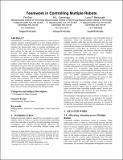| dc.contributor.author | Gao, Fei | |
| dc.contributor.author | Bertuccelli, Luca F. | |
| dc.contributor.author | Cummings, M. L. | |
| dc.date.accessioned | 2013-10-25T13:10:16Z | |
| dc.date.available | 2013-10-25T13:10:16Z | |
| dc.date.issued | 2012-03 | |
| dc.identifier.isbn | 9781450310635 | |
| dc.identifier.uri | http://hdl.handle.net/1721.1/81765 | |
| dc.description.abstract | Simultaneously controlling increasing numbers of robots requires multiple operators working together as a team. Helping operators allocate attention among different robots and determining how to construct the human-robot team to promote performance and reduce workload are critical questions that must be answered in these settings. To this end, we investigated the effect of team structure and search guidance on operators' performance, subjective workload, work processes and communication. To investigate team structure in an urban search and rescue setting, we compared a pooled condition, in which team members shared control of 24 robots, with a sector condition, in which each team member control half of all the robots. For search guidance, a notification was given when the operator spent too much time on one robot and either suggested or forced the operator to change to another robot. A total of 48 participants completed the experiment with two persons forming one team. The results demonstrate that automated search guidance neither increased nor decreased performance. However, suggested search guidance decreased average task completion time in Sector teams. Search guidance also influenced operators' teleoperation behaviors. For team structure, pooled teams experienced lower subjective workload than sector teams. Pooled teams communicated more than sector teams, but sector teams teleoperated more than pool teams. | en_US |
| dc.description.sponsorship | United States. Office of Naval Research | en_US |
| dc.description.sponsorship | United States. Air Force Office of Scientific Research | en_US |
| dc.language.iso | en_US | |
| dc.publisher | Association for Computing Machinery (ACM) | en_US |
| dc.relation.isversionof | http://dx.doi.org/10.1145/2157689.2157703 | en_US |
| dc.rights | Creative Commons Attribution-Noncommercial-Share Alike 3.0 | en_US |
| dc.rights.uri | http://creativecommons.org/licenses/by-nc-sa/3.0/ | en_US |
| dc.source | MIT web domain | en_US |
| dc.title | Teamwork in controlling multiple robots | en_US |
| dc.type | Article | en_US |
| dc.identifier.citation | Fei Gao, Missy L. Cummings, and Luca F. Bertuccelli. 2012. Teamwork in controlling multiple robots. In Proceedings of the seventh annual ACM/IEEE international conference on Human-Robot Interaction (HRI '12). ACM, New York, NY, USA, 81-88. | en_US |
| dc.contributor.department | Massachusetts Institute of Technology. Department of Aeronautics and Astronautics | en_US |
| dc.contributor.department | Massachusetts Institute of Technology. Engineering Systems Division | en_US |
| dc.contributor.mitauthor | Gao, Fei | en_US |
| dc.contributor.mitauthor | Cummings, M. L. | en_US |
| dc.contributor.mitauthor | Bertuccelli, Luca F. | en_US |
| dc.relation.journal | Proceedings of the seventh annual ACM/IEEE international conference on Human-Robot Interaction (HRI '12) | en_US |
| dc.eprint.version | Author's final manuscript | en_US |
| dc.type.uri | http://purl.org/eprint/type/ConferencePaper | en_US |
| eprint.status | http://purl.org/eprint/status/NonPeerReviewed | en_US |
| dspace.orderedauthors | Gao, Fei; Cummings, Missy L.; Bertuccelli, Luca F. | en_US |
| dc.identifier.orcid | https://orcid.org/0000-0002-3412-3813 | |
| mit.license | OPEN_ACCESS_POLICY | en_US |
| mit.metadata.status | Complete | |
